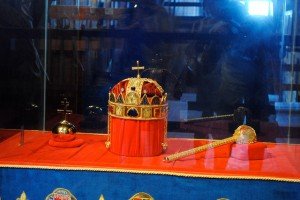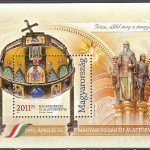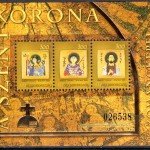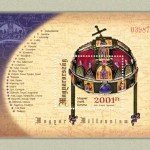This article marks the beginning of our Hungaria Stamp Exchange blog. The purpose is to portray major topics in Hungarian history and culture and their influence on the stamps of Hungary through a series if articles. Each article will begin with information on the topic and then be followed by some discussion and depiction of the stamps relating to this topic.
The first topic is St. Stephen’s crown. The crown has been richly portrayed in stamps from the second definitive issue to today. Planned future topics are Heroes Square and the Millennium monument, the Lanchid (Chain Bridge), 1919 Occupation of Hungary, the historical city of Pecs and Hungarian artists. Your suggestions are welcome for additional topics of interest to you. We hope you’ll enjoy the blog and send us your comments.
Szent Korona, the Holy Crown of Hungary, is also known as the Crown of Saint Stephen and was the coronation crown used by the Kingdom of Hungary for most of its existence. St. Stephen was the first king of Hungary to be crowned with it continuing on to more than fifty kings since then. History dictates that the official coronation of the king cannot take place without this crown.
The crowning of Stephen I, who later became Saint Stephen, marks the beginning of Hungarian statehood in the year 1000. St Stephen I held up the crown during the coronation to offer it to the the Virgin Mary to seal a divine contract between her and the crown. From this time forward, the Virgin Mary was depicted as patron saint for the Kingdom of Hungary and as regina (i.e. “queen”). This contract was supposed to empower the crown with a divine force to help the future kings of Hungary
It was first called the Holy Crown in 1256. The Hungarian coronation insignia consists of the Holy Crown, the sceptre, the orb, and the mantle. The orb has the coat-of-arms of Charles I of Hungary (1310–1342); the other insignia can be linked to Saint Stephen. During the 14th century royal power came to be represented not simply by a crown, but by just one specific object: the Holy Crown. This also meant that the Kingdom of Hungary was a special state: they were not looking for a crown to inaugurate a king, but rather, they were looking for a king for the crown.
Since the year 2000, the Holy Crown has been on display in the central Domed Hall of the Hungarian Parliament Building. On our family visit to Budapest, we were able to see a replica of the crown of St. Stephen at the castle in Visegrad, pictured at the beginning of this article.
St. Stephen’s Crown and stamps
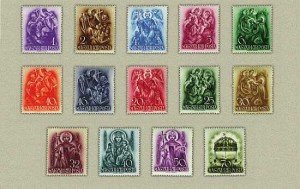 The first occurrences of St. Stephen’s Crown on stamps are the first two definitive issues of Hungary – the numeral issue of 1874-1899 and the Turul issue 0f 1900-1916. All stamps issued by Hungary from 1874 to 1916 had a small replica of the crown on the stamp. The first full picture of the crown was on the St. Stephen’s commemorative set of 1938 which is pictured above. The 70f stamp illustrates the crown.
The first occurrences of St. Stephen’s Crown on stamps are the first two definitive issues of Hungary – the numeral issue of 1874-1899 and the Turul issue 0f 1900-1916. All stamps issued by Hungary from 1874 to 1916 had a small replica of the crown on the stamp. The first full picture of the crown was on the St. Stephen’s commemorative set of 1938 which is pictured above. The 70f stamp illustrates the crown.
 The first individual picture of the stamp is the 1940 stamp, issued to commemorate the recovery of Transylvania from Romania. Madonna, the Virgin Mary, the patron saint of Hungary was honored in the very valuable 1932 set, also shown above.
The first individual picture of the stamp is the 1940 stamp, issued to commemorate the recovery of Transylvania from Romania. Madonna, the Virgin Mary, the patron saint of Hungary was honored in the very valuable 1932 set, also shown above.
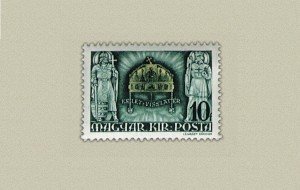 Over the years many other Hungarian stamps have been issued to commemorate St. Stephen and the “Szent Korona”.
Over the years many other Hungarian stamps have been issued to commemorate St. Stephen and the “Szent Korona”.
Since the Millennium, the Hungarian post has been issuing souvenir sheets to commemorate the Szent Korona. A few examples of the 2001, 2006 and 2011 sheets are pictured above.
The wide variety of beautiful Hungarian stamps relating to St. Stephen’s crown would make both an extremely interesting topical collection and a dazzling exhibit for the Hungarian specialist.
